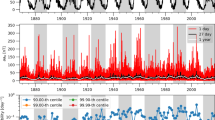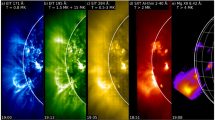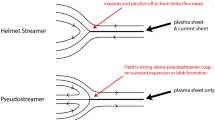Abstract
With coordinated observations of the NOAA 15 satellite and OUL magnetometer station in Finland, we report that the electromagnetic ion cyclotron (EMIC) waves which were stimulated by the compression of the magnetosphere drive relativistic electron precipitation in geoquiescence on 1 Jan 2007. After an enhancement of solar wind dynamic pressure (SWDP), a dayside Pc1 pulsation was observed by the OUL station. Such a Pc1 pulsation is caused by an EMIC wave which propagates from the generation source to lower altitudes. Simultaneously, the NOAA 15 satellite registered an enhancement of precipitating electron count rates with energies >3 MeV within the anisotropic zone of protons. This phenomenon is coincident with the quasi-linear theoretical calculation presented in this paper. Our observations suggest that after a positive impulse of solar wind, the compression-related EMIC waves can drive relativistic electrons precipitation and play a pivotal role in the dynamic of radiation belts.
Similar content being viewed by others
References
Baker D N, Belian R, Higbie P R, et al. Deep dielectric charging effects due to high energy electrons in the Earth’s outer magnetosphere. J Electrost, 1987, 20: 3–19
Reeves G D, McAdams K L, Friedel R H W, et al. Acceleration and loss of relativistic electrons during geomagnetic storms. Geophys Res Lett, 2003, 30: 1529
Zong Q G, Zhou X Z, Wang Y F, et al. Energetic electron response to ULF waves induced by interplanetary shocks in the outer radiation belt. J Geophys Res, 2009, 114: A10204
Summers D, Ma C, Mukai T. Competition between acceleration and loss mechanisms of relativistic electrons during geomagnetic storms. J Geophys Res, 2004, 109: A04221
Miyoshi Y, Sakaguchi K, Shiokawa K, et al. Precipitation of radiation belt electrons by EMIC waves, observed from ground and space. Geophys Res Lett, 2008, 35: L23101
Su Z P, Xiao F L, Zheng H N, et al. CRRES observation and STEERB simulation of the 9 October 1990 electron radiation belt dropout event. Geophys Res Lett, 2011, 38: L06106
Yuan Z, Li M, Xiong Y, et al. Simultaneous observations of precipitating radiation belt electrons and ring current ions associated with the plasmaspheric plume. J Geophys Res Space Physics, 2013, 118: 4391–4399
Bortnik J, Thorne R M. The dual role of ELF/VLF chorus waves in the acceleration and precipitation of radiation belt electrons. J Atmos Sol Terr Phys, 2007, 69: 378–386
Fu H S, Cao J B, Mozer F S, et al. Chorus intensification in response to interplanetary shock. J Geophys Res, 2012, 117: A01203
Fu H S, Cao J B, Zong Q G, et al. The role of electrons during chorus intensification: Energy source and energy loss. J Atmos Sol Terr Phys, 2012, 80: 37–47
Summers D, Ni B, Meredith N P. Timescales for radiation belt electron acceleration and loss due to resonant wave-particle interactions: 2. Evaluation for VLF chorus, ELF hiss, and the electromagnetic ion cyclotron waves. J Geophys Res, 2007, 112: A04207
Thorne R M. Radiation belt dynamics: The importance of wave-particle interactions. Geophys Res Lett, 2010, 37: L22107
Hayosh M, Santolík O, Parrot M. Location and size of the global source region of whistler mode chorus. J Geophys Res, 2010, 115: A00F06
Bortnik J, Thorne R M, Meredith N P. The unexpected origin of plasmaspheric hiss from discrete chorus emissions. Nature, 2008, 452: 62–66
Yuan Z, Xiong Y, Pang Y, et al. Wave-particle interaction in a plasmaspheric plume observed by a Cluster satellite. J Geophys Res, 2012, 117: A03205
Fu H S, Cao J B, Yang B, et al. Electron loss and acceleration during storm time: The contribution of wave-particle interaction, radial diffusion, and transport processes. J Geophys Res, 2011, 116: A10210
Xu W Y, Du A M. Energy budget of the magnetosphere-ionosphere system in solar Cycle 23. Sci China Tech Sci, 2012, 55: 1184–1188
Yuan Z, Zhao L, Xiong Y, et al. Energetic particle precipitation and the influence on the sub-ionosphere in the SED plume during a super geomagnetic storm. J Geophys Res, 2011, 116: A09317
Lyons L R, Thorne R M. Equilibrium structure of radiation belt electrons. J Geophys Res, 77, 1973: 5608–5617
Summers D, Thorne R M. Relativistic electron pitch angle scattering by electromagnetic ion cyclotron waves during geomagnetic storms. J Geophys Res, 2003, 108: 1143
Hu Y, Denton R E, Johnson J R. Two-dimensional hybrid code simulation of electromagnetic ion cyclotron waves of multi-ion plasmas in a dipole magnetic field. J Geophys Res, 2010, 115: A09218
Johnson J R, Cheng C Z. Can ion cyclotron waves propagate to the ground? Geophys Res Lett, 1999, 26: 671–674
Engebretson M J, Lessard M R, Bortnik J, et al. Pc1-Pc2 waves and energetic particle precipitation duringand after magnetic storms: Su perposed epoch analysis and case studies. J Geophys Res, 2008, 113: A01211
Yuan Z, Xiong Y, Wang D, et al. Characteristics of precipitating energetic ions/electrons associated with the wave-particle interaction in the plasmaspheric plume. J Geophys Res, 2012, 117: A08324
Liu Y H, Fraser B J, Menk F W. EMIC waves observed by Cluster near the plasmapause. J Geophys Res Space Physics, 2013, 118: 5603–5615
Fraser B J, Nguyen T S. Is the plasmapause a preferred source region ofelectromagnetic ion cyclotron waves in the magnetosphere? J Atmos Terr Phys, 2011, 63, 1225–1247
Horne R B, Thorne R M. On the preferred source location for the convective amplification of ion cyclotron waves. J Geophys Res, 1993, 98: 9233–9247
Horne R B, Thorne R M. Convective instabilities of electromagnetic ion cyclotron waves in the outer magnetosphere. J Geophys Res, 1994, 99: 17259–17273
Yuan Z, Deng X, Lin X, et al. The link between EMIC waves in a plasmaspheric plume and a detached sub-auroral proton arc with observations of Cluster and IMAGE satellites. Geophys Res Lett, 2010, 37: L07108
Yuan Z, Xiong Y, Huang S, et al. Cold electron heating by EMIC waves in the plasmaspheric plume with observations of the Cluster satellite. Geophys Res Lett, 2014, 41: 1830–1837
Anderson B J, Hamilton D J. Electromagnetic ion cyclotron waves stimulated by modest magnetospheric compressions. J Geophys Res, 1993, 98: 369–11382
Usanova M E, Mann I R, Rae I J, et al. Multipoint observations of magnetospheric compression-related EMIC Pc1 waves by THEMIS and CARISMA. Geophys Res Lett, 2008, 35: L17S25
Usanova M E, Mann I R, Kale Z C, et al. Conjugate ground and multisatellite observations of compression-related EMIC Pc1 waves and associated proton precipitation. J Geophys Res, 2010, 115: A07208
McCollough J P, Elkington S R, Baker D N. The role of Shabansky orbits in compression-related electromagnetic ion cyclotron wave growth. J Geophys Res, 2012, 117: A01208
Yahnin A G, Yahnina T A. Energetic proton precipitation related to ion-cyclotron waves. J Atmos Terr Phys, 2007, 69: 1690–1706
Zhu H, Su Z P, Xiao F L, et al. Nonlinear interaction between ring current protons and electromagnetic ion cyclotron waves. J Geophys Res, 2012, 117: A12217
Lyons L R, Thorne R M, Kennel C F. Pitch-angle diffusion of radiation belt electrons within the plasmasphere. J Geophys Res, 1972, 77: 3455–3474
Su Z P, Zhu H, Xiao F L, et al. Bounce-averaged advection and diffusion coefficients for monochromatic electromagnetic ion cyclotron wave: Comparison between test-particle and quasi-linear models. J Geophys Res, 2012, 117: A09222
Su Z P, Zhu H, Xiao F L, et al. Latitudinal dependence of nonlinear interaction between electromagnetic ion cyclotron wave and radiation belt relativistic electrons. J Geophys Res, 2013, 118: 3188–3202
Millan R M, Lin R P, Smith D M, et al. X-ray observations of MeV electron precipitation with a balloon-borne germanium spectrometer. Geophys Res Lett, 2002, 29: 2194
Sandanger M, Søraas F, Aarsnes K, et al. Loss of relativistic electrons: Evidence for pitch angle scattering by electromagnetic ion cyclotron waves excited by unstable ring current protons. J Geophys Res, 2007, 112: A12213
Rodger C J, Raita T, Clilverd M A, et al. Observations of relativistic electron precipitation from the radiation belts driven by EMIC waves. Geophys Res Lett, 2008, 35: L16106
Carson B R, Rodger C J, Clilverd M A. POES satellite observations of EMIC-wave driven relativistic electron precipitation during 1998–2010. J Geophys Res Space Physics, 2012, 118: 232–243
Evans D S, Greer M S. Polar Orbiting Environmental Satellite Space Environment monitor-2 Instrument Descriptions and Archive Data Documentation. Boulder, Colorado: Space Environ. Lab.. 2004
Tsyganenko N A, Sitnov M I. Modeling the dynamics of the inner magnetosphere during strong geomagnetic storms. J Geophys Res, 2005, 110: A03208
Hayakawa M, Shimakura S, Kobayashi T, et al. A study of polarization of irregular pulsations of diminishing period and their generation mechanism. Planet Space Sci, 1992, 40: 1081–1091
McCollough J P, Elkington S R, Baker D N. Modeling EMIC wave growth during the compression event of 29 June 2007. Geophys Res Lett, 2009, 36: L18108
Carpenter D L, Anderson R R. An ISEE/whistler model of equatorial electron density in the magnetosphere. J Geophys Res, 1992, 97: 1097–1198
Sheeley B W, Moldwin M B, Rassoul H K, et al. An empirical plasmasphere and trough density model: CRRES observations. J Geophys Res, 2011, 106: 25631
Grew R S, Menk F W, Clilverd M A, et al. Mass and electron densities in the inner magnetosphere during a prolonged disturbed interval. Geophys Res Lett, 2007, 34: L02108
Ludlow G R, Cornilleau-Wehrlin N, Hughes W J. Simultaneous observation of a Pc1 pulsation by the air force geophysics laboratory magnetometer network and GEOS 1. J Geophys Res, 1989, 94: 6633–6642
Summers D. Quasi-linear diffusion coefficients for field-aligned electromagnetic waves with applications to the magnetosphere. J Geophys Res, 2005, 110: A08213
Author information
Authors and Affiliations
Corresponding author
Rights and permissions
About this article
Cite this article
Wang, D., Yuan, Z., Deng, X. et al. Compression-related EMIC waves drive relativistic electron precipitation. Sci. China Technol. Sci. 57, 2418–2425 (2014). https://doi.org/10.1007/s11431-014-5701-3
Received:
Accepted:
Published:
Issue Date:
DOI: https://doi.org/10.1007/s11431-014-5701-3




